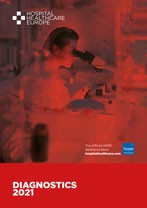A novel breathalyser which makes use of a reaction between nitric oxide, oxygen and ammonia to create a unique breath print can be used to identify patients infected with COVID-19.
This is the conclusion from a study by a team from Department of Internal Medicine, The Ohio State University Wexner Medical Center, Ohio, United States.
In patients with a viral infection, the inflammatory response leads to be production of several volatile compounds which can serve as biomarkers for the disease.1 These volatile compounds can be identified with electronic detection devices (so-called ‘e-noses’) which contain an array of sensors that are optimised for a different chemical range. For example, an e-nose makes use of nanoparticle sensors which contain organic molecules with functional groups that react with volatile organic compounds in a breath sample, leading to a volume change such as swelling or shrinking, and which can be subsequently detected by a sensor.2
But rather than relying on a multiplex-array for the detection of volatile compounds in breath, the US team developed a unique, single, selective chemo sensor. With the current breathalyser once breath enters the device, the sensor interacts with the gas molecules producing an electrical signal. The sensor itself is composed of a catalytically active semiconductor material, based on tungsten trioxide and which specifically targets nitric oxide and ammonia in breath. In fact, the sensor was developed in 2008 and was shown to be still able to detect minute levels of nitric oxide gas in the presence of interfering volatile organic compounds.3
For their study, the team recruited participants, with a positive PCR test for COVID-19 and who were admitted to an intensive care unit receiving mechanical ventilation. Breath samples were collected on days 1, 3, 7 and 10 of the study or until patients no longer required mechanical ventilation.4
Findings
A total of 46 patients were included, 23 of whom were COVID-19 positive and the others who were all negative and served as a control group. Among the COVID-19 positive cohort, the median age was 61 years (61% male). Using the breathalyser, the authors identified three typical analytical patterns which they termed the NO-pattern, NH3/O2-pattern and the omega pattern, which was specific to patients with COVID-19 and arose from the interaction between nitric oxide, ammonia and oxygen in the exhaled samples. This omega pattern was detectable within 72 hours of the onset of respiratory failure and identified in 14 of those with confirmed COVID-19 on day 1 but only 4 of those in the control group and this difference was statistically significant (p < 0.0001).
Interestingly, the authors also reported on how as patients’ clinical symptoms resolved, the omega pattern disappeared, and they generally transitioned to the NO pattern through the course of their illness.
The authors determined that the omega pattern had a sensitivity of 88% and a specificity of 83% for COVID-19 on day 1 and concluded that future studies are needed to determine which other diseases or infections might benefit from their technology.
References
- Gouma PI, Wang LS, Simon SR, Stanacevic M. Novel Isoprene Sensor for a Flu Virus Breath Monitor. Sensors-Basel. 2017;17(1):199.
- Shan B et al. Multiplexed nanomaterial-based sensor array for detection of COVID-19 in exhaled breath. ACS Nano 2020;14(9):12125–32.
- Gouma PI et al. A selective nano sensing probe for nitric oxide. Appl Phys Lett 2008;93:244102.
- Exline MC et al. Exhaled nitric oxide detection for diagnosis of COVID-19 in critically ill patients. PLoS One 2021;16(10):e0257644.





